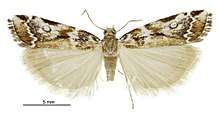Orocrambus ornatus
Orocrambus ornatus is a moth in the family Crambidae. This species is endemic to New Zealand. It is classified as critically endangered by the Department of Conservation.
| Orocrambus ornatus | |
|---|---|
 | |
| Male | |
| Scientific classification | |
| Kingdom: | |
| Phylum: | |
| Class: | |
| Order: | |
| Family: | |
| Genus: | |
| Species: | O. ornatus |
| Binomial name | |
| Orocrambus ornatus (Philpott, 1927) | |
| Synonyms | |
| |
Taxonomy
O. ornatus was first described by Alfred Philpott in 1927[2] using a male specimen he collected in Golden Downs on 8 January 1926.[3][4] Philpott named the species Crambus ornatus.[2] George Vernon Hudson described and illustrated the species under the same name in 1939.[5] In 1975 David Edward Gaskin assigned Crambus ornatus to the genus Orocrambus.[4]
Description
Philpott described the species as follows:
20 mm. Head and palpi ochreous. Antennae brown. Thorax brown mixed with white. Abdomen whitish-ochreous. Legs white, anterior pair fuscous. Forewings, costa moderately arched, apex blunt-pointed, termen rounded, oblique; brassy brown to chocolate brown; markings white; a basal patch on costa half enclosing a brown area; a broad irregular band at 1⁄4, not reaching dorsum, outwardly strongly dentate; on fold before this a large spot of mingled blackish and white scales; an elongate black mark about middle of wing at 1⁄3; a crescentic white area sprinkled with brown on costal half from about 1⁄3 to 4⁄5, enclosing an elongate spot of blackish-brown on costal margin; beneath this costal spot a prominent ring of brown enclosing a white area with a central brown dot; second line pure white, dentate, preceded on costa by a small blackish-brown dot and followed by a much larger one; a white area beneath the latter reaching apex; fringes fuscous, irregularly barred with white. Hindwings and fringes pale ochreous-grey.[2]
Distribution
This species is endemic to New Zealand[6][7] and has been recorded in Golden Downs in the Tasman District[4] as well as in the Nelson district.[8]
Ecology and habitat
O. ornatus appears to prefer forest habitat.[8] Adults have been recorded on wing in January.[4]
Conservation Status
This species has the "Nationally Critical" conservation status under the New Zealand Threat Classification System.[1]
References
| Wikimedia Commons has media related to Orocrambus ornatus. |
- Hoare, R.J.B.; Dugdale, J.S.; Edwards, E.D.; Gibbs, G.W.; Patrick, B.H.; Hitchmough, R.A.; Rolfe, J.R. (2017). "Conservation status of New Zealand butterflies and moths (Lepidoptera), 2015" (PDF). New Zealand Threat Classification Series. 20: 6.
- Philpott, Alfred (1927). "Notes and descriptions of New Zealand Lepidoptera". Transactions and Proceedings of the New Zealand Institute. 58: 80–92 – via Papers Past.
- Dugdale, J. S. (1988). "Lepidoptera - annotated catalogue, and keys to family-group taxa" (PDF). Fauna of New Zealand. 14: 149. Retrieved 1 May 2018.
- Gaskin, D. E. (1975). "Revision of the New Zealand Crambini (Lepidoptera: Pyralidae: Crambinae)". New Zealand Journal of Zoology. 2 (3): 265–363. doi:10.1080/03014223.1975.9517878.
- Hudson, George Vernon (1939). A supplement to the butterflies and moths of New Zealand. Wellington: Ferguson & Osborn Ltd. p. 419.
- "Orocrambus ornatus (Philpott, 1927)". www.nzor.org.nz. Landcare Research New Zealand Ltd. Retrieved 1 May 2018.
- Gordon, Dennis P., ed. (2010). New Zealand inventory of biodiversity. Volume two. Kingdom animalia : chaetognatha, ecdysozoa, ichnofossils. Vol. 2. Christchurch, N.Z.: Canterbury University Press. p. 457. ISBN 9781877257933. OCLC 973607714.
- Patrick, Brian; Dugdale, John S. (2000). Conservation status of the New Zealand Lepidoptera (PDF). Wellington, New Zealand: Department of Conservation. p. 28. ISBN 978-0478218671.
